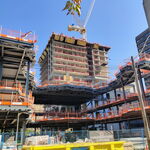Neutrino
Senior Member
That's a lot of parking they're contemplating. GO is associated with "drive to the train." Now it will also be "drive to the bus." Hopefully the fares will be more affordable than taking the 407.
407 ETR does charge public transit - and I believe they charge them the commercial truck rates too, which are significantly more than a passenger vehicle.
The primary reason for the transitway is that the 407 will not run free-flow forever - much of the highway is now at it's ultimate design width, and moving into the future it will start to be increasingly congested.
407 ETR does charge public transit - and I believe they charge them the commercial truck rates too, which are significantly more than a passenger vehicle.
The primary reason for the transitway is that the 407 will not run free-flow forever - much of the highway is now at it's ultimate design width, and moving into the future it will start to be increasingly congested.
I thought GO was charged a special rate (in the form of a single annual payment), partly because they're a bulk user, and partly because the 407 company realized it's in their business interests to maintain friendly relations with the provincial government.
Bless you for being so faithful in the business practices of a foreign owned consortium
There is a place for autonomous buses in infrastructure, and they may indeed replace some LRTs where ridership does not warrant it....I don't think we'll see any LRTs ever replace VIVA or ZUM routes. By the time the may be justified from a ridership perspective, 2035+, buses will be electric and autonomous-enough to operate on existing segregated ROWs. You'll be able to have AV buses that platoon as well, essentially LRT without the rail. You'll essentially get the benefits of LRT, without having to invest in the hard infrastructure.
https://pwayblog.com/2016/09/07/maglev-guideway-design/[...]
From design perspective, all the magnetic levitation systems are guided systems, similar (not only) from this perspective to roads and railways.
Together with the specifics of this modern system, the Maglev guideway requires also an alignment design. The principles of maglev guideway alignment design are similar to the ones used, for example, in railway track alignment design, with some subtle differences.
[...]
York Region. He is the incumbent.^ where is he running? The site didn't load well on my phone.





